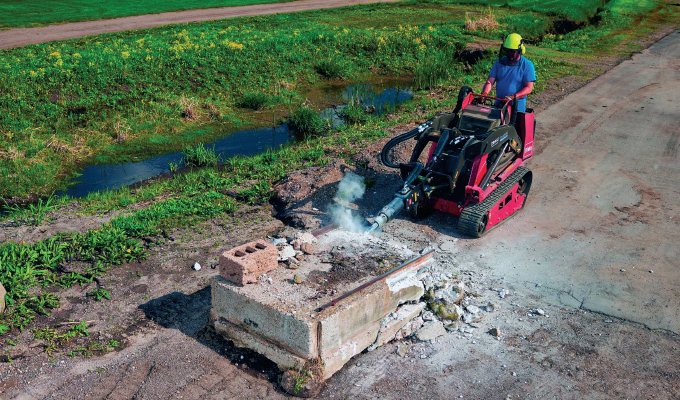Compact utility loaders (CULs) have been gaining remarkable momentum in recent years, and rightfully so. These powerful, durable, and versatile machines are a hit in the compact equipment industry. With the CUL segment gaining in popularity, this category has already started giving compact track loader and skid steer loader manufacturers a run for their money.
CULS ON THE RISE
Contractors, both large and small, continue searching for creative and effective ways to maximize their overall capital equipment investments. We know that a CUL generally has a smaller upfront investment than its rivals in the skid steer loader and compact track loader classes. However, in addition to offering you a bigger bang for your buck, do CULs also deliver high-performing results on the jobsite?
In the past, contractors realized the benefit of the smaller upfront investment with CULs; however, they were a bit skeptical of how the CUL would perform on a typical large-scale jobsite.
Luckily, with recent major technological enhancements from popular CUL manufacturers like Toro, contractors are realizing that CULs can lift as much or even more than entry-level skid steer and track loaders. It’s evident that when you have a CUL, you can take advantage of all the other benefits associated with a smaller machine. Not to mention the lower upfront and ongoing maintenance costs when compared with skid steers or track loaders.
OPERATIONAL COST SAVINGS
Numbers aside, in terms of performance, there are really three main reasons that any contractor looking to minimize operational costs should consider. First, compact utility loaders can go places skid steer loaders and compact track loaders cannot. Thanks to the compact footprint and lower overall operating weight, the machine is both easier to transport and typically nimbler and maneuverable on the jobsite.
Second, the fact that operators can mount and dismount the machine easily is a feature that can be very attractive for contractors and equipment operators. If a specific job requires crew members to get in and out of a machine frequently, the CUL class has the edge. Stepping off the platform is objectively much simpler than climbing in and out of the cab of a machine.
Finally, a CUL offers superior visibility over a skid steer loader or a compact track loader. Where the latter two classes of equipment rely on mirrors and backup cameras, the compact utility loader class requires the operator to simply turn their heads for a panoramic, unobstructed view of their surroundings.

NEXT GENERATION OF CULS
There are also several innovative and intuitive features that have been engineered into the CUL category. Here are a few of the smart features that would make an excellent choice for any contractor to include in their fleet: effortless controls, which allow the operator to have all the controls of the machine on an easy-to-navigate control panel at their fingertips; a high-drive track system which mimics the design of many CTL models and ensures that it can withstand the demanding conditions of a construction site; and comparative height and reach statistics when compared to entry-level SSLs and CTLs.
And, they’re getting more powerful and innovative. For example, in February 2019, Toro introduced the Dingo TXL 2000, which harnesses all the benefits of a compact utility loader with an outstanding rated operating capacity of 2,000 pounds and telescoping loader arms. They’re also getting smarter. The next generation of CULs is also starting to feature electric compact equipment, with the introduction of the world’s first revolutionary electric Dingo—the Toro® e-Dingo™ 500 compact utility loader. With an operating capacity of 515 pounds, the e-Dingo allows contractors to utilize all the benefits and power of a standard compact utility loader with no fuel costs and zero exhaust emissions. Higher efficiency and reliable performance set the e-Dingo apart for faster completion times and higher ROI for rental partners. It’s also powered by lithium-ion battery technology designed for tasks that require heavy or continuous operation for indoor applications. Now that electric-powered equipment has found its way into the CUL category, contractors could anticipate even more popularity with CULs. After all, people do enjoy using machines that are lighter, quicker, high-performing, and sustainable—factors they can expect to find in CULs, specifically in electric-powered CULs.
CLOSING THOUGHT
When you break it all down, CULs are an outstanding alternative to the two other equipment classes. They now have the power to rival their larger equipment counterparts and the intelligently engineered features to make the compact utility loader not only a legitimate option, but potentially a superior option on the jobsite for light-, mid-, and heavy-duty applications alike.
About the author
Kyle Cartwright is the marketing manager at Toro, a leading worldwide provider of innovative solutions for the outdoor environment including turf and landscape maintenance, snow management, rental and construction equipment, and irrigation solutions. For more, visit www.toro.com.
Modern Contractor Solutions, May 2020
Did you enjoy this article?
Subscribe to the FREE Digital Edition of Modern Contractor Solutions magazine.



